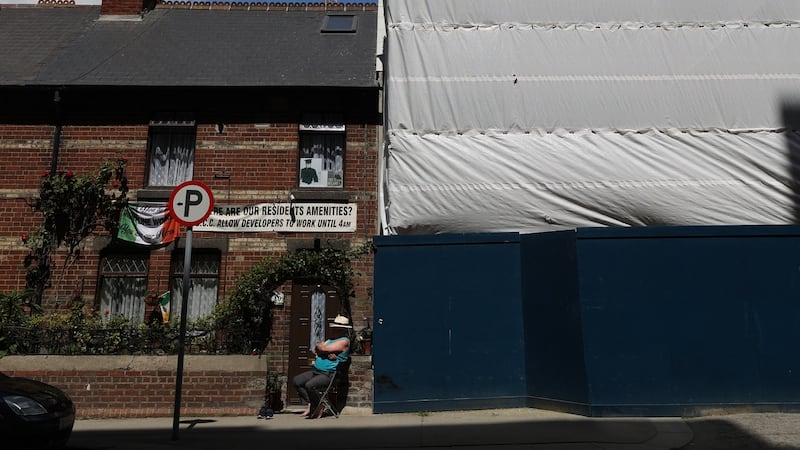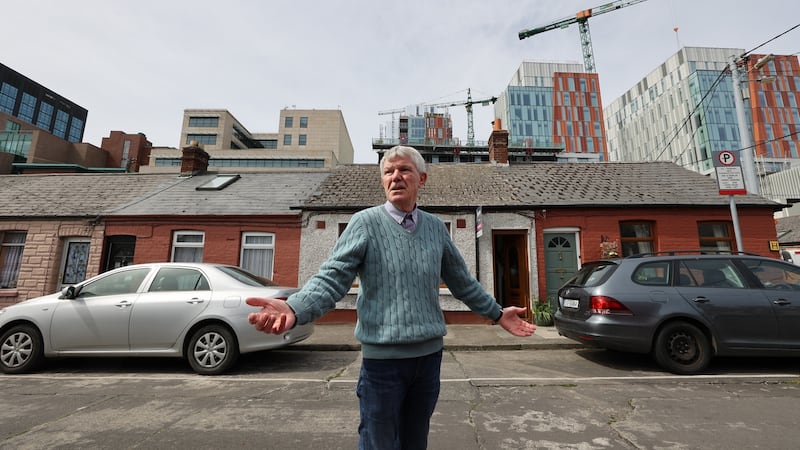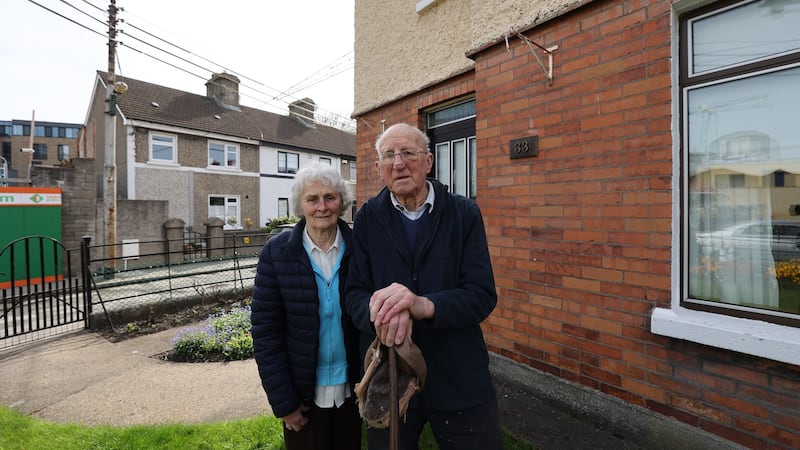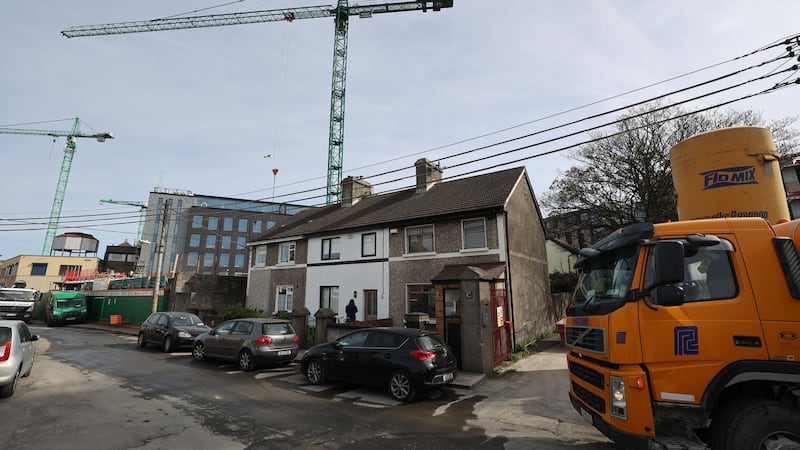On Mayor Street in Dublin's Docklands a row of 10 houses by a new Luas track is overshadowed by huge developments. Tommy Byrne, a 73-year-old retired Fás employee, lives with his wife at one end of this row. He has an Irish flag on his red brick wall with a thank you to frontline workers printed on it and he also has a big off-white sign that reads: "Where are our residents' amenities?" His next door neighbour has a sign that reads "Safe Developer Zone" the first initials in red to make the acronym SDZ, mocking the so-called "Strategic Development Zone" in which they live (Strategic Development Zones are areas of "strategic national economic and social importance" in which building can be fast-tracked).
Sixty-three-year-old Tony McDonnell, Byrne’s neighbour from the pebble-dashed house at the other end of the row, joins us. McDonnell is a retired firefighter who works as a health and safety consultant. He has lived in his house since 1992. For 23 years, he says, they’ve been fighting developments that steal their light and disturb their peace. “The building starts at seven in the morning until the evening and a half day Saturday,” says McDonnell.
“The Alamo is what we call it,” says Byrne.
“It’s new Dublin being pushed up against old,” says McDonnell. “It’s the old story of what the seagull said to the aeroplane. ‘I was here first.’”
It all started, he says, with the original development of the docklands, what he calls "mini Manhattan", in 1998 and it hasn't let up since. "We're probably the only residents in Europe to have had continuous development, with its associated dirt, noise and dust for 23 years. Part of health and safety is that building workers should watch out for lots of things but one of the things is silica dust, concrete dust, because over their work time, it can gather and they can get silicosis. Now, we're longer here than any worker has been here."
McDonnell was an area representative on the Dublin Docklands Authority’s council when the current SDZ scheme was being formulated. “They say there was consultation,” he says. “But when they showed us the size and the scale, for the first time, I said to them ‘Sure the residents will never see the sun again.’ And the answer was, ‘We can’t allow a group of houses prevent the economic recovery of Dublin.’ They already had [it] pre-determined, before they compiled it, before they got the imprimatur of An Bord Pleanala.”
We walk into Byrne's house, past a sign on his doorway that says, in print "No junk mail from Fianna Fáil politicians." He has added "Fine Gael" in marker. We pass a dark sitting room in which Byrne has a shelf of Greek and Roman statuettes.
“I’ve lost all the light coming into the front room,” he says. “Our heating bills are gone through the roof. We’ve lost the sunlight. My lights are on from the time I wake in the morning.”
“Pen pushers decided we would have a percentage of sunshine per annum,” says McDonnell. “I thought only God could do that. It’s God’s sun, God’s earth but they’ve decided in their wisdom that they’d afford me and Tommy and the other residents a percentage.”
Out in the lane behind Byrne’s house he has a loft for his racing pigeons and canaries. There’s a plaque on the loft commemorating the old Austin factory that used to be next door and would test cars along the lane.

The Kennedy Wilson apartments being built by Sisk next door already loom over Byrne's house. Previously there was a factory with a double peaked roof designed to facilitate the gable window on Byrne's house. The new plans allowed the builders to build a wall against Byrne's window. "When Dublin city council gave the planning permission," says McDonnell. "I said at a meeting 'The man has a gable window.' And they said, 'Yeah, well he can go to court and sort that out.' That was the answer. Tommy's a pensioner – where is he going to get money to go to court to defend what he already had?"
In the end, the builders built Byrne a skylight in his roof. “But they could have told him to get stuffed,” says McDonnell.
The lack of light even affects his birds, says Byrne. “Their breeding period would be knocked off skew… I’ve lost three or four of them because of the cranes. They would have flown into them.”
Kennedy Wilson and Sisk were invited to contribute to this article, but at time of publication had not offered a comment.
The residents here feel totally unrepresented. When Dublin City Council took over from Dublin Docklands Authority the residents on Mayor Street were, for unclear reasons, removed from the board. And local politicians have done nothing as far as Byrne is concerned. "There's only 10 votes here."
As we walk out of the house, he says: “I had a stroke over this place in 2016… The stress of it. No one was helping us.”
I walk down the street with McDonnell to his house where once, he says, he had “a horizon that went down to Sir John Rogerson’s Quay.”

Now, across from his house there's a big sun-blocking hotel and a new Salesforce building next to it. Beside him, overlooking his garden is Johnny Ronan's Spencer Place North, where they recently built extra floors that they have started taking down. Beside McDonnell's house is a hoarding with Ronan's name on it, in case he forgot who was doing this. The Ronan name is also on the many cranes looming behind the house. "They dominate you," he says.
As we talk a very loud Luas roars by and we have to wait for it to pass. “That noise used to dissipate [but] with the buildings now the noise doesn’t dissipate so it’s magnified,” says McDonnell. “We didn’t even get a pane of glass for double or triple glazing.”
McDonnell knows that nothing will stop these developments now, but he can’t understand why something can’t be done for the 10 households on Mayor Street. They still pay property taxes, he says, even though they “couldn’t give their houses away in a raffle.” Some EU directives, he tells me, force developments to halt if they interfere with protected wildlife. “There are certain bats or beetles or spiders that have more standing than we have.”
In response to a query from The Irish Times on the residents’ issues, Ronan Group issued this statement: “Ronan Group recognises the challenges all housing development causes to existing residents during construction and every effort is made to minimise disruption, with residents’ views taken into account. At a time of a severe shortage of housing, this development will provide nearly 500 badly-needed homes.”
Mairead Brady, a librarian, lives with her partner and child in a cottage in Gerald Street in Ringsend. They've been surrounded by huge new developments (including the still-in-progress Boland's Mill development) for so long that when building stopped due to Covid, "it was unsettling because I'd got used to the noise." In fact, she says she prefers "the banging to the sound of the cranes in the wind. That's kind of eerie".
Brady loves the area. “It has a community spirit that is very, very unique. After our neighbour Maureen passed away, another lady knocked on the door [with] an Easter egg. And the reason was because Maureen would have done it if Maureen was still here.”
The big tech companies and financial companies nearby have led to an influx of younger professionals to this older community living both in the houses and apartment blocks nearby. She quite likes the mix but she’s conscious that this view is not shared by older residents. “It’s like two different worlds,” she says.
She has even got to know a lot of the builders who park on her street. “They arrive at five or six in the morning and when I was maybe eight months pregnant, I used to find it hard to sleep and a lot of them would salute me in the morning. And then when I had my baby, I remember they were giving me the thumbs up.”

Mairead's next-door neighbour, 73-year-old Fran Pedreschi, is descended from Tuscan builders who came to build the Western Road Church in 1850. He is more upset about how the area has changed so he's selling up and moving out to Irishtown.
“You’re not moving out because of me, are you Fran?” asks Mairead.
He laughs. Mairead is a very good neighbour, he says. “But the community’s gone. You don’t know who owns these houses now. That house there is rented out for €2,700 a month… That’s more than a mortgage…. The attitude of the people around here was, ‘Won’t it be great for the area.’ But as it went on it wasn’t great. It just destroyed the area. People moved out. They were getting huge money for these houses.”
I point at the big buildings around us. What was there before Mason Hayes and Curran? "Bishop's fertiliser," says Fran.
And what was there before Google?” “The gas company,” says Fran.
“Fifteen years ago you could walk out there and it was nice and quiet,” he says.
Karen Muldowney, another neighbour, is out walking her dog when she stops to join the discussion. Her house is next to a new enterprise centre. "We used to have lovely sunshine in front of my house and now [there's] a shadow cast and it's freezing cold," she says.
“My back garden was a suntrap and now it’s gone,” says Fran.
And the builders can be messy, says Fran. They leave rubbish on their windowsills and one of them removed a clamp from his van with an angle grinder and threw it against his door, damaging it. The others confirm that removing clamps with angle grinders is something some of the builders do sporadically.
When Fran is having his photo taken, two passing builders ask what we’re doing and I explain what I’m writing about. “Ah, it’s terrible,” says one of them. “I don’t know how they put up with it.”

Noel Clarke, a retired metal fabricator, and his wife Kay are in their beautifully tended garden in Clarence Mangan Road in Dublin 8, as a huge lorry manoeuvres its way to the noisy construction site behind them. Thirty-seven built-to-let apartments are being constructed there ranging from three to seven storeys in height. Some student accommodation has also been recently built in the area facing them. "We are considerate constructors" reads a nearby sign erected by the builders, BAM.
“All the balconies are looking into our back gardens,” says Noel. “We’ll have no privacy.”
An overlooked garden is a big deal to Noel, who spends most of his time working there (he specialises in bonsaiing trees – “oak, ash, sycamore”). And then there’s the noise. The builders’ trucks have spent months reversing down the narrow roads sometimes damaging the footpaths. Residents put up with construction noise all day from 7am and half a day on Saturday. Noel does not believe there was any real consultation. “The developer does not speak to the little people,” he says.
So how do they cope with the noise? “It’s driving me mad,” says Kay. “I can’t stay in the house. Then with the lockdown you’re limited with where you can go.” (A little later I meet Kay out for a walk and she says: “See what I mean!”)
“I’ve two hearing aids and I can lower them,” says Noel. “But then I can’t hear my wife calling when the dinner is ready. [For a while] there was a piledriver that went on for several hours every day. They said it was monitored but they haven’t given us the readings.”

When contacted by The Irish Times, BAM said in a statement that it “complies at all times with all the planning, building regulations and derogations in respect of the Sweeney’s Corner Apartment project. Since the outset of this project, there has been a structured and well-run platform for engagement with the local community, including the issuing of newsletters to residents on a regular basis. We value our relationships with the communities where we work and all issues and complaints are taken seriously.”
Brian McCarthy, Noel’s neighbour from across the road, tells me that his wife went into labour to the sound of the piledriver that was set up 12 metres from their house. “I took a video of it because I was so perplexed it could happen... If we had been on site, we’d have been made wear protective gear… but because we’re off site in a residential property, despite being only 12 metres from a pile driver, there was no consideration afforded to us at all.”

McCarthy lives with his young family in a terrace of three houses caught between the new student accommodation on Sweeney’s Corner and the site of the apartments that will also run up by Noel and Kay’s garden. In the past, he says, he looked favourably on developments in the city and viewed the resulting inconvenience as a necessary evil. He doesn’t even particularly mind that his garden is overlooked by student balconies. But when the residents’ submitted their concerns as part of the planning process and none of those concerns were, in his view, reflected in the planning approval, and when their subsequent complaints about the noise and inconvenience were treated as a nuisance by both the builders and the authorities, he changed his position significantly.
“If anyone lives beside a site where there is a planning application,” he says, “I would be telling them to become as difficult as possible, as quickly as possible, with a view to hindering the developers as much as possible from the get-go, as opposed to going into it naively like we did and… being treated as poorly as I think we’ve been treated.”





















